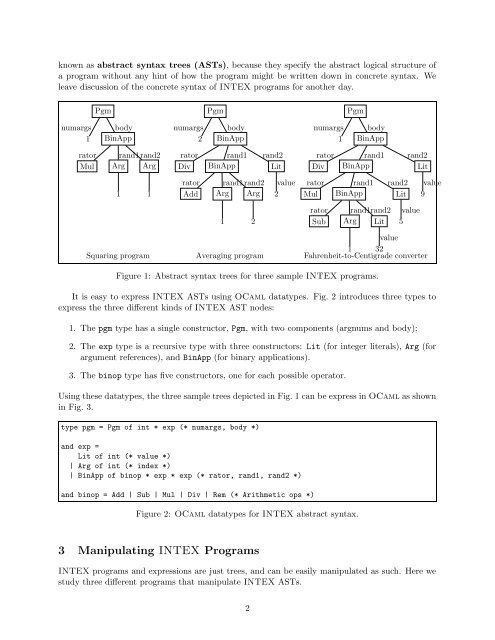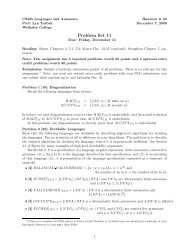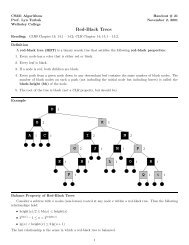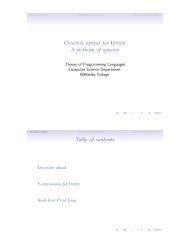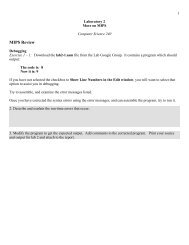Intex 1 Introduction 2 Abstract Syntax for INTEX - Wellesley
Intex 1 Introduction 2 Abstract Syntax for INTEX - Wellesley
Intex 1 Introduction 2 Abstract Syntax for INTEX - Wellesley
You also want an ePaper? Increase the reach of your titles
YUMPU automatically turns print PDFs into web optimized ePapers that Google loves.
known as abstract syntax trees (ASTs), because they specify the abstract logical structure of<br />
a program without any hint of how the program might be written down in concrete syntax. We<br />
leave discussion of the concrete syntax of <strong>INTEX</strong> programs <strong>for</strong> another day.<br />
numargs<br />
1<br />
rator<br />
Mul<br />
Pgm<br />
body<br />
BinApp<br />
rand1rand2<br />
Arg Arg<br />
1<br />
1<br />
numargs<br />
2<br />
rator<br />
Div<br />
rator<br />
Add<br />
Pgm<br />
body<br />
BinApp<br />
rand1<br />
BinApp<br />
rand1 rand2<br />
Arg Arg<br />
1<br />
2<br />
rand2<br />
Lit<br />
value<br />
2<br />
numargs<br />
1<br />
rator<br />
Div<br />
rator<br />
Mul<br />
rator<br />
Sub<br />
Pgm<br />
body<br />
BinApp<br />
rand1<br />
BinApp<br />
rand1<br />
BinApp<br />
rand1rand2<br />
Arg Lit<br />
rand2<br />
Lit<br />
rand2<br />
Lit<br />
value<br />
5<br />
Squaring program Averaging program<br />
value<br />
1 32<br />
Fahrenheit-to-Centigrade converter<br />
Figure 1: <strong>Abstract</strong> syntax trees <strong>for</strong> three sample <strong>INTEX</strong> programs.<br />
It is easy to express <strong>INTEX</strong> ASTs using OCaml datatypes. Fig. 2 introduces three types to<br />
express the three different kinds of <strong>INTEX</strong> AST nodes:<br />
1. The pgm type has a single constructor, Pgm, with two components (argnums and body);<br />
2. The exp type is a recursive type with three constructors: Lit (<strong>for</strong> integer literals), Arg (<strong>for</strong><br />
argument references), and BinApp (<strong>for</strong> binary applications).<br />
3. The binop type has five constructors, one <strong>for</strong> each possible operator.<br />
Using these datatypes, the three sample trees depicted in Fig. 1 can be express in OCaml as shown<br />
in Fig. 3.<br />
type pgm = Pgm of int * exp (* numargs, body *)<br />
and exp =<br />
Lit of int (* value *)<br />
| Arg of int (* index *)<br />
| BinApp of binop * exp * exp (* rator, rand1, rand2 *)<br />
and binop = Add | Sub | Mul | Div | Rem (* Arithmetic ops *)<br />
Figure 2: OCaml datatypes <strong>for</strong> <strong>INTEX</strong> abstract syntax.<br />
3 Manipulating <strong>INTEX</strong> Programs<br />
<strong>INTEX</strong> programs and expressions are just trees, and can be easily manipulated as such. Here we<br />
study three different programs that manipulate <strong>INTEX</strong> ASTs.<br />
2<br />
value<br />
9


